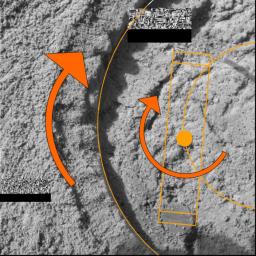
|
Grinding Wheel Profile
- Click the image above for a larger view
- Full-Res JPEG (965 x 965) (226.9 kB)
- Full-Res TIFF (965 x 965) (1.9 MB)
Caption:
This graphic dubbed by engineers as the "Grinding Wheel Profile" is the detective's tool used by the Opportunity team to help them understand one of the processes that formed the interior of a rock called "McKittrick." Scientists are looking for clues as to how layers, grains and minerals helped create this rock, and the engineers who built the rock abrasion tool (RAT) wanted to ensure that their instrument's handiwork did not get confused with natural processes.
In the original microscopic image underlaying the graphics, engineers and scientists noticed "layers" or "scratches" on the spherical object nicknamed "blueberry" in the lower right part of the image. The designers of the rock abrasion tool noticed that the arc length and width of the scratches were similar to the shape and size of the rock abrasion tool's grinding wheel, which is made out of a pad of diamond teeth.
The scrapes on the bottom right blueberry appear to be caused by the fact that the berry got dislodged slightly and its surface was scraped with the grinding pad. In this image, the largest yellow circle is the overall diameter of the hole ground by the rock abrasion tool and the largest yellow rectangular shape is the area of the grinding wheel bit. The smaller yellow semi-circle is the path that the center of the grinding tool follows. The orange arrow arcing around the solid yellow circle (center of grinding tool) indicates the direction that the grinding tool spins around its own center at 3,000 revolutions per minute. The tool simultaneously spins in an orbit around the center of the hole, indicated by the larger orange arrow to the left.
The grinding tool is 22 millimeters (0.9 inches) in length and the actual grinding surface, which consists of the diamond pad, is 1.5 millimeters (0.06 inches) in length, indicated by the two smaller rectangles. You can see that the smaller bottom rectangle fits exactly the width of the scrape marks.
The grooves on the blueberry are also the same as the curvature of the arced pathway in which the grinding tool spins.
By overlaying appropriately scaled representations of the rock abrasion tool schematics, the evidence reveals a strong indication that the scrapes on the blueberry were induced by the tool, rather than caused by some natural geologic process.
The two rectangular boxes in the lower left and upper middle parts of this image are "drop outs," where the data packets inadvertently did not make it back to Earth during the initial communications relay via the Deep Space Network antennas. The missing data packets should be resent to Earth within the next few days. Just above each of the black "drop out" rectangles is another rectangular area filled with a cluster of smaller rectangles in different shades of gray, which are image compression artifacts.
The rock abrasion tools on both Mars Exploration Rovers were supplied by Honeybee Robotics, New York, N.Y.
Cataloging Keywords:
| Name | Value | Additional Values |
|---|---|---|
| Target | Mars | |
| System | ||
| Target Type | Planet | |
| Mission | Mars Exploration Rover (MER) | Deep Space Network (DSN) |
| Instrument Host | Opportunity (MER-B) | |
| Host Type | Rover | |
| Instrument | Microscopic Imager (MI) | Rock Abrasion Tool (RAT) |
| Detector | ||
| Extra Keywords | Color, Radio, Rotation | |
| Acquisition Date | ||
| Release Date | 2004-02-25 | |
| Date in Caption | ||
| Image Credit | NASA/JPL/Cornell/US Geological Survey | |
| Source | photojournal.jpl.nasa.gov/catalog/PIA05446 | |
| Identifier | PIA05446 | |
